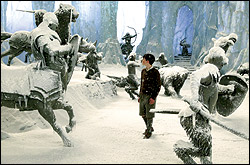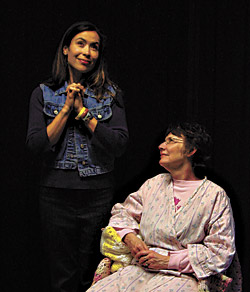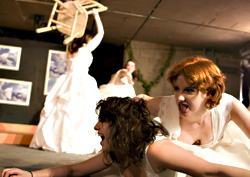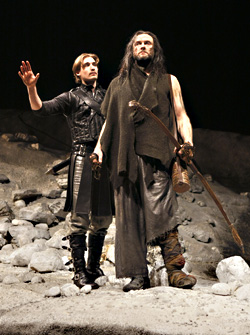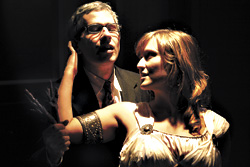It took a passel of calamities to torment C.S. Lewis into writing The Chronicles of Narnia: The Lion, the Witch and the Wardrobe (which opens Friday, Dec. 9, at the Metro and other theaters), the 1948 children’s book whose “deep magic” rivals Harry Potter in sales. Lewis’ friendship with J.R.R. Tolkien, which sparked the Christian conversion that won him immortal celebrity, had cooled to ice. His surrogate mother-figure, Janie Moore, was sinking into vicious senility, prompting memories of his real mother’s death when he was 13. His brother, Warnie, was diving into the shallow magic of a booze bottle. Worse, as he later admitted, an Oxford philosophy colleague “demolished” his argument for Christianity.
So Lewis plunged into his own childhood and came back with the redemptive story of Narnia, a wintry otherworld reachable via the rather vaginal passageway of a wardrobe lined with fur coats. His four child protagonists enter the wardrobe and emerge born again into a Christian allegory wherein Aslan (Christ), the self-sacrificing lion, battles for their souls against the White Witch (inspired by the irascible rationalist, Elizabeth Anscombe, who trounced him at Oxford).
Well, all that suffering was worth it for readers, who will mostly like this film treatment, even if they’re heathen. Shrek director Andrew Adamson honorably adapts the tale, with flashes of magic—in Narnia, at least. The scenes leading up to the kids’ escape into fantasy are drably everyday. The 1942 London blitz forces their mom to send the kids—big brother Peter (William Moseley), big sis Susan (Anna Popplewell), kid brother Edmund (Skandar Keynes), and kid sister Lucy (Georgie Henley)—to the safer country manse of Professor Kirke (Jim Broadbent, wasted amid this tedium).
In snowy Narnia, the pace picks up. Lucy, the movie’s heroine, first stumbles onto the snowy secret place, visits a terrified faun (James McAvoy) in his Hobbity home, and excitedly tells the other kids the Good News. They’re secularly skeptical until she, a little child, leads them to the land of truth. Edmund, a selfish, disobedient boy, frighteningly flirts with the witch (Tilda Swinton) and winds up clapped in irons in her igloolike castle keep. To the rescue, Lucy and her older siblings team up with some marvelous CGI animal pals led by a pair of cockney beavers (voiced by Ray Winstone and Dawn French).
The effects are less epic and awesome than those of the PG-13-rated Lord of the Rings. Fauns clip-clop convincingly, beavers waddle through authentic snowdrifts, winged creatures angelic and scaly ply skies in Newtonianly sound and quite thrilling arcs. Aslan has his fauns and centaur, the witch her Minotaur, plus scary Hags and Orclike Boggles. The chase scenes, across woods and a perilously thawing frozen waterfall, work well, and the battle scenes, if judged against anything this side of LOTR, are rousing.
The child actors are mainly disastrous, except for Henley. Her irresistible crooked grin is a triumph over British dentistry. She makes Dakota Fanning look like a calculating android. Her best work is with McAvoy, who portrays craven fear, spiritual temptation, and the triumph of the will in a way to give Lewis’ soul wings. Swinton’s pale face and restrained manner are perfect for the witch—she’s colder than the polar bears who pull her sleigh.
Most of the humans are upstaged by the animals, including Rupert Everett’s silky, untrustworthy fox and Liam Neeson’s problematic Aslan. He looks, moves, and speaks brilliantly, thanks to the excellent CGI animators, but Neeson’s voice only conveys an uninspiring blankness of character that needs his considerable physical presence to transcend. They should’ve gone with Brian Cox.
Aslan keeps interrupting Narnia to save the kids in a way that makes allegorical sense, not storytelling sense. But I guess you could say the same about crucifixion and resurrection in the Bible. And this is only a PG-rated crucifixion, not The Passion of the Christ. Since everyone will compare this movie to LOTR and Harry Potter, here’s how I think it stacks up: a pale echo of the Tolkien trilogy, worse than Alfonso Cuarón’s third Harry Potter film, better than Chris Columbus’ first two, and about on a par with Mike Newell’s new Goblet of Fire.
That son of Adam, director Adamson, will win over the Christian faithful (even some of us Darwinian Christians). But I don’t think non- or anti-Christians should flee the flick. Simply subtract all that subtext, and you’re left with a work of fitful magic, like Harry Potter’s broomstick. At its core is something we all can agree is profound and true: the suffering of the motherless little boy Clive Staples Lewis, the gift of the 10-year-old Georgie Henley, and the undying fable that brought their talents together.
